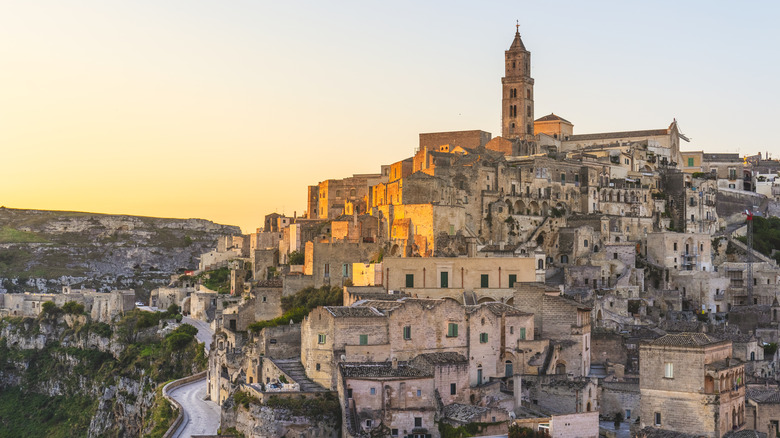The Oldest City In Italy Is An Underrated Ancient Gem Where History Lovers Will Thrive
If you're a history buff or just love exploring the past, you'll know of Italy's landmarks. Perhaps you've been to Rome's awe-inspiring Appian Way (lined with tombs and memorials) or the iconic Colosseum to dream of its ancient gladiatorial battles. However, if you plan on being in the lovely Puglia region, with its whitewashed houses and sunny weather, you should visit an ancient city called Matera. It is so ancient that it's the second longest continuously inhabited spot after Jordan's Petra. It is understandably a UNESCO World Heritage Site and is truly unique. The city of Matera has been inhabited since the Paleolithic Age, and many of those who've resided there over the centuries had dwellings carved right out of the soft tufa rock.
These places are called "sassi" ("rock" in Italian), and there are homes, cisterns, churches, and tombs carved out of it. People lived there without heat or running water, and the community eventually became run down and impoverished. In the 1950s, the government made people leave and move to a different part of the city. However, in the 1980s, people moved back and renovated these ancient structures; you can even stay in one now. How can you resist?
Getting to Matera and staying in a sassi
To get to Matera from Rome, take a train to Bari (about four hours) before jumping on a regional train from Bari Centrale to Matera Centrale, a journey of 90 minutes or so. Splurge on some good walking shoes because Matera has a lot of stairs and climbing. You'll likely want to visit a sassi right away, so head to the Casa Noha to get a good idea of what it was like, from when the dwellings began to the exodus of the residents and subsequent renovations. Entry is around $5.40. You can also check out Casa Grotta, a furnished sassi that gives an alternative look at life in a rock home. Sometimes, these dwellings were carved on top of each other, which is a fascinating visual. As you walk around the town, you can also stop at La Palomba, a free open-air sculpture park that was once a quarry. It's full of work by artist Antonio Paradiso.
You can even enjoy dinner in a cave. One fabulous spot is Trattoria del Caveoso, which serves dishes like orecchiette Matera-style with pasta, tomatoes, pork sausage, and cardoncelli mushrooms, or Podolica beef filet. Cave hotels are also available, like Caveoso Hotel, a stunning property that will set you back between $156 and $294 for a double room in September (at the time of this writing). It isn't every day you get to sleep in a cave, after all.
Things to see in and around Matera
In Matera, it wasn't only homes and cisterns carved from rock. The ancient city also has rock churches called "rupestrian" churches. One incredible one to visit is the 14th-century Chiesa Rupestre di Santa Maria di Idris (above), which was rebuilt after a collapse in the 15th century. You can go inside for a tour (which will also take you to sassi houses) and climb the observation tower. Other rock churches are the eighth-century Santa Lucia alle Malve (still in use) and San Pietro Barisano, which was started in the 12th century and enlarged over the centuries. You can see the somewhat macabre basement rooms where the corpses of priests were "drained" and dressed for burial. There are frescoes inside some churches, but please don't touch them — the oil from your hands can damage and destroy the precious art.
Another spot to check out is the Palombaro Lungo, or the underground cistern, which was also carved from the tufa rock. It was created in the 16th century to collect rainwater for the citizens of Matera, and while it's no longer in use, you can visit the cavernous spot and marvel at the carving work. It's underground, making it a great way to cool down after the heat of Matera's sun.
